What does the bike fit service involve?
In brief following the completion of a subjective questionnaire an initial physical assessment will be undertaken by the Physiotherapist to gain an understanding of a cyclists body shape, flexibility and whether there are any functional weaknesses or asymmetries relative to cycling. This is followed by an observation of the cyclist pedalling on a static turbo trainer on his/her bicycle.
A variety of measurements of the cyclist and the bicycle will be taken throughout the bike fit to enable appropriate adjustments in order to optimise an individuals position relative to the type and level of riding. We are all different shapes and sizes with varying trunk and limb lengths and ultimately the bike should be manipulated to fit the individual cyclist. Minor adjustments can be significant when you think of the repetitive nature of the pedalling action.









